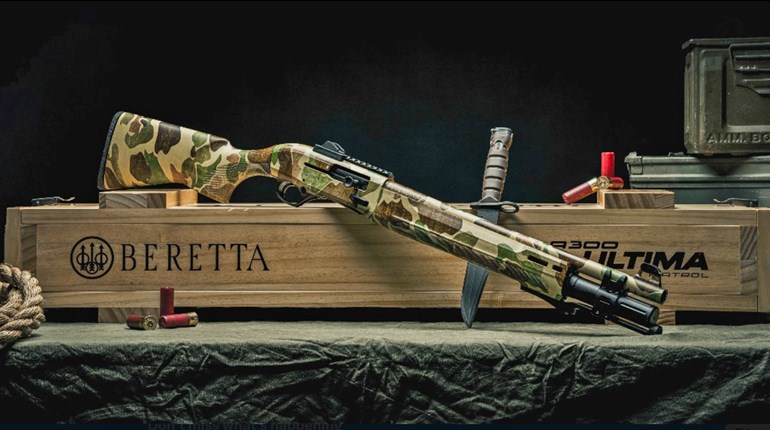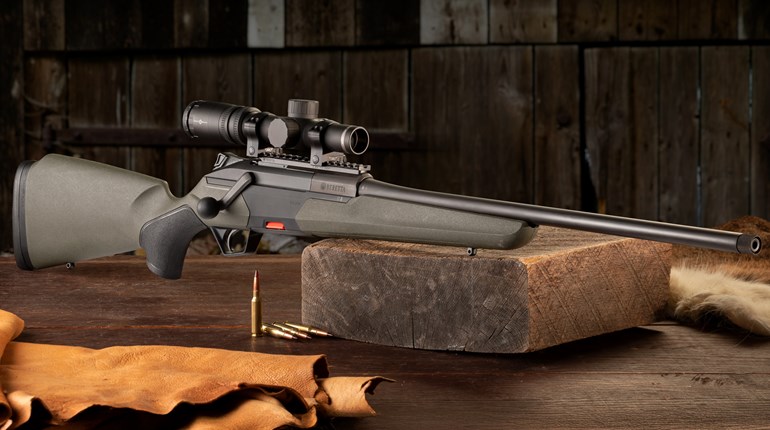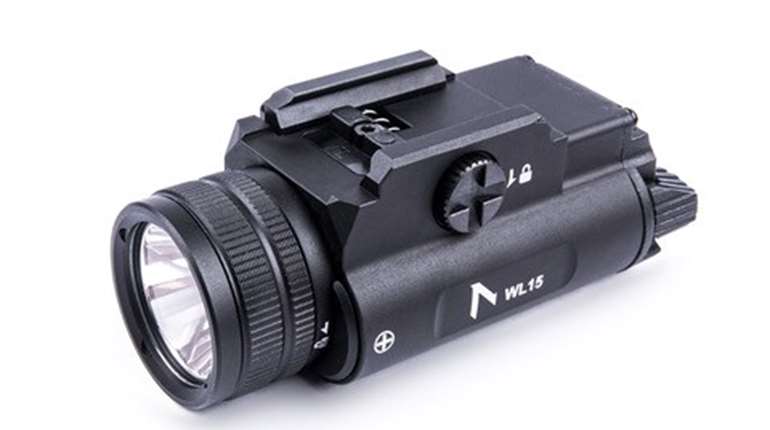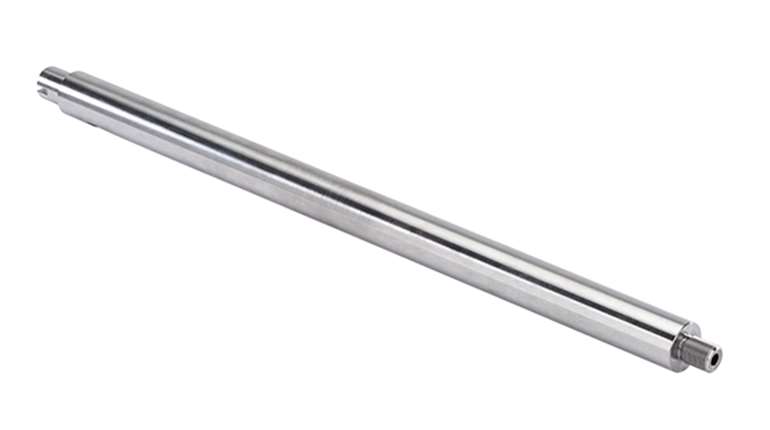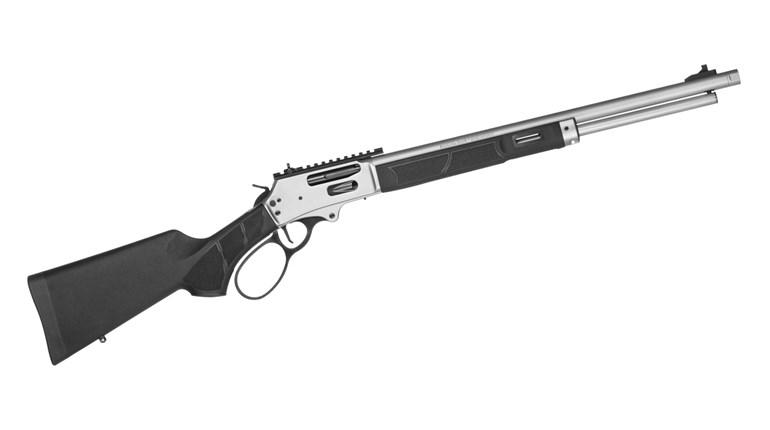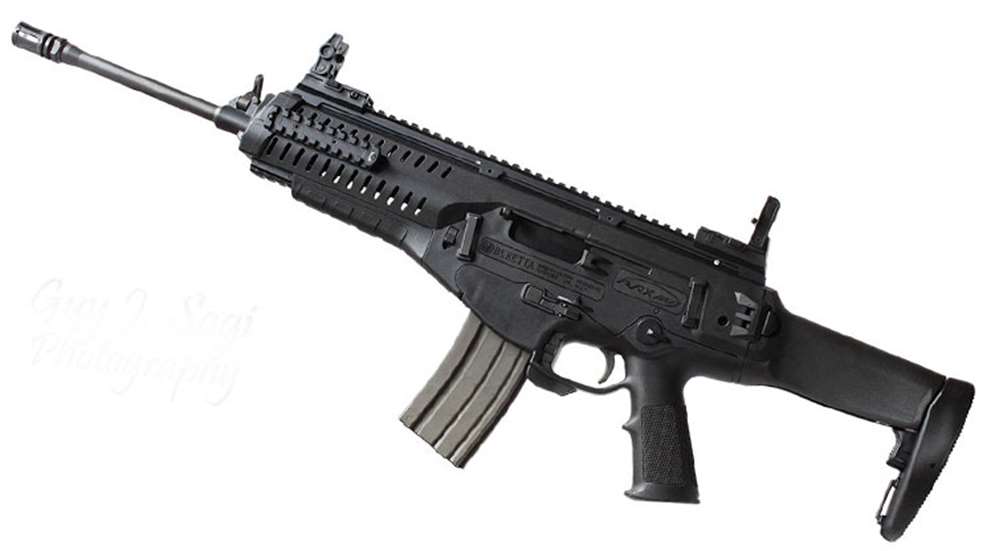
Ten times better than the M16? That was the point Beretta boasted in the naming of the ARX160, the company's new 5.56 NATO, selective-fire rifle introduced in 2008 as a possible replacement for its AR70/90 platform in service with the Italian armed forces. Arguable as that claim might be, the ARX160 certainly embodies a number of characteristics that can only be described as advanced and outside-the-box.
The same polymer construction, engineering and racy lines that make the ARX160 a standout are now available in a semi-automatic-only version of the rifle. Built in America by Beretta USA, the ARX100 derives most of its features from its military counterpart, including a short-stroke gas system, side-folding buttstock and quick-change barrel mechanism.
Continuing with modern enhancements, Beretta developed the ARX100 to be fully ambidextrous by placing fire controls and sling-attachment points on both sides of the rifle. In addition, shooters can easily switch the charging handle from the left side of the gun to the right, and they can choose right or left ejection. Neither of these changes requires disassembly, and conversion takes seconds. A closer look reveals the adaptability and futuristic design of the ARX100 make it a cutting-edge defensive rifle—no matter from which side shooters operate it.
Polymer Progeny
Vast improvements in polymers spurred Beretta to use these materials wherever feasible when developing the ARX160. The success of the company's efforts is readily apparent in the ARX100, as the rifle's upper and lower receivers are molded from what the industry has come to call "technopolymer." Thorough torture-testing showed the state-of-the-art material to be highly resilient, and Beretta was able to rely on polymer extensively to keep the weight of the ARX100 at less than 7 pounds.
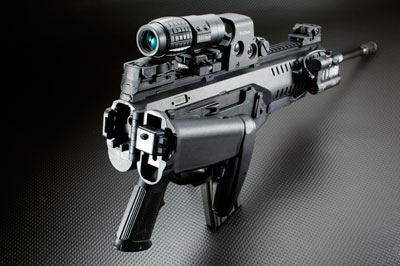
The bolt group—together with an improved AK-style recoil-spring system and a sliding polymer dustcover—rides mostly along polymer tracks. Close tolerances keep out debris, while the properties of the polymer provide oil-free lubrication. In the long run, the design just may prove superior to traditional systems that use aluminum-alloy receivers.
Both the buttstock and the fore-end are integral to the monolithic upper. (The ARX100 upper will not accept the ARX160 lower, preventing the commercial version from being converted to selective fire.) A push-button release near the rear of the receiver on its left side allows the stock to fold to the right. Below the ejection port, a triangular-shaped projection retains the stock in the folded position. All operating controls are accessible when the buttstock is folded, and the rifle can be fired in this state. Simple to adjust, the four-position stock has a trigger-like lever beneath its cheekpiece that, when pressed, permits extension or retraction. A nonslip rubber buttpad provides added purchase.
The full-length, aluminum-alloy top rail appears to follow MIL-STD-1913 specs and provides ample room for optics. Near the front of the fore-end on each side is an alloy rail for mounting lights, lasers and other accessories. A fourth, molded rail runs along the bottom edge of the fore-end. While the front portion of this rail is exposed and looks like the others, the rear portion is hidden by a removable cover. Sliding off the cover reveals a mounting platform for a 40 mm grenade launcher, obviously a carry-over from the ARX160.
The ARX100 also borrows its sights from its predecessor. Developed for the ARX160, the folding, polymer sights pair a front post that is adjustable for both windage and elevation with a rotating, wheel-type rear aperture that has five settings for 100 to 600 meters.
Adding to the ambidextrous design of the rifle, six attachment points permit the use of a variety of sling styles. One is located near the toe of the buttstock, another rotates 180 degrees over the gas block, and two more are present on each side of the upper, fore and aft of the ejection port. All are permanent. While the sling mount on the gas block has a conventional oval shape, the others resemble flattened loops.
An undercut trigger guard and a checkered pistol grip, both integral to the lower, work together to provide good purchase. Just above the grip, the ambidextrous selector switch rotates 90 degrees from "safe" to "fire." There is a magazine-release button on each side of the lower just behind the magazine well, plus another one located on the bottom of the trigger guard. An ambidextrous, vertically sliding switch near the front of the trigger guard offers manual control of the bolt. Push it up to lock the bolt to the rear; push it down to release.
Switching in Seconds
Although the ARX100 operates via a short-stroke gas system, it is technically not the piston, but the gas cylinder, that moves to the rear. The piston remains fixed to the gas block while the captive cylinder slides back and forth over it, acting against a short operating rod that is part of the bolt carrier to initiate cycling. This fixed-piston design is used in the AR-18/AR-180 and a number of other rifles. It is sometimes referred to as a spigot system, but it works almost the same as a short-stroke piston.
The seven-lug, rotating bolt has two extractors, one on either side. These not only provide positive extraction; either can be selected to serve as the ejector. Open on both sides of the ARX100, the ejection port allows the bolt to expel brass to the right or left, depending on the shooter's choice.
A sliding steel plate housed in the lower receiver's polymer buffer plate governs which side brass is ejected from the action. Accessed by a hole in either side of the upper receiver forward of the buttstock, the steel plate can be pushed to the right or left by using a bullet tip or other pointed object. If the plate is pushed to the right, the ARX100 will eject to the right. If it's pushed to the left, ejection will occur on that side.
A clever design makes this possible. On each side of the bolt, a spring-loaded rod connected to its own extractor/ejector extends to the rear. Pushed to the right, the plate blocks the left extractor rod when the bolt travels to the rear during cycling. The blocked rod forces the left extractor forward of the bolt head to now serve as an ejector. While the right extractor retains the rim of the cartridge case, the ejector pushes on the left side of the case and ejects it to the right. Moving the plate to the left produces the opposite effect, turning the right extractor into an ejector.
Along with right or left ejection, the ARX100 has a swinging charging handle that can be positioned on either side of the rifle. Withdraw the bolt group to a designated indentation on the receiver, and then pull the charging handle out to the side to lock the bolt in place. Rotate the handle through the open ejection port to the opposite side. When the handle stops perpendicular to the receiver, push it back into the bolt assembly. This unlocks the bolt, which will immediately spring forward, so make sure no fingers are in the ejection port. With practice, switching the charging handle and ejection to the opposite side can be done in about 5 seconds.
The ARX100 is equipped with a match-grade, cold-hammer-forged barrel that measures 16 inches long. It ends in an A2-style flash hider attached via 1⁄2x28 muzzle threads. Except for the sling mount on the gas block, and a single contact point between the gas system and the operating rod closer to its rear, the "pencil-thin" barrel is free-floating.
Even more simple than switching the charging handle or ejection is changing the barrel. On each side of the upper receiver just behind the fore-end are opposing barrel-release tabs. After locking the bolt to the rear, press down on both tabs while pulling the barrel forward to remove it from the upper. Reinsertion is as easy as keeping both tabs depressed while guiding the barrel back into place. The ARX100's barrel-change system lacks only something to hold on to when the barrel is hot.
While the ARX100 is currently offered in 5.56 NATO only, its military counterpart is also chambered for 5.45x39 mm, 7.62x39 mm and 6.8x43 mm SPC II. Armies from several countries field these variations. Beretta USA may offer similar barrels for consumers, but demand will dictate which chamberings go to market.
Tool-Free Takedown
Disassembling the ARX100 for cleaning and maintenance requires several unconventional steps, but the process is not difficult to master after some practice. To start, make sure the rifle is unloaded and on "safe," lock the bolt to the rear, and remove the barrel group. Further disassembly of the barrel group is not recommended.
Pull back on the cocking handle, allow the bolt group to slowly travel forward and fold the buttstock. Now hold the rifle vertically, with the front face of the fore-end against a solid surface. Push the selector switch past the "safe" position as far as it will go with one thumb while using a couple fingers from the same hand to press forward on the exposed buffer plate. Maintaining pressure on the buffer plate, use the other hand to push the pistol grip and lower receiver outward from the upper receiver. A few raps on the pistol grip may be necessary to free the lower. Once it is removed from the upper, do not disassemble the lower any further.
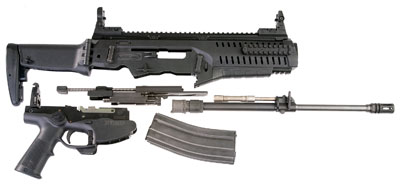
To remove and disassemble the bolt, first bring the charging handle back to the takedown indentation in the receiver. Pull out the handle, rotate it into the center of the ejection port and then pull the bolt group out the rear of the receiver. Depress the buffer at the rear of the recoil-spring guide rod, and rotate these components 90 degrees to unlock them. Then, pull the subgroup containing the captive recoil spring and dustcover rearward to remove it from the bolt carrier. Bring the bolt out the rear of the carrier while rotating it back and forth so the cam pin can make its way through the channel in the carrier. Push the firing pin forward, and free the cam pin from the bolt. The firing pin and its spring can now be removed from the rear of the bolt.
Follow the above steps in reverse to reassemble the rifle. Once the bolt group is assembled and placed back inside the upper receiver, remember to rotate the charging handle and push it in to allow the bolt to go forward. Then, insert the lower's buffer plate into the upper, and snap the two receiver halves together. Finally, lock the bolt back, and install the barrel. No tools are required for disassembly or reassembly.
Adaptable and Accurate
I put the versatility of the ARX100 to the test on the range, mounting a number of optics and accessories to its rails to fit my evaluation drills. The top rail easily accommodated (in separate instances, of course) an Aimpoint CompM4 red-dot optic with a 3XMag magnifier, an EOTech EXPS2 reflex sight and a Vortex Viper 1-4x24 mm riflescope. I mounted a DBAL-A2 laser designator from Laser Devices to one of the side rails and attached a Grip Pod GPS-02 vertical foregrip/bipod to the bottom rail.
In addition to the M16-style magazine Beretta supplied with the ARX100, I used several brands of GI mags, Magpul PMags, 40-round MWG IK-520s and SureFire MAG5-60, 60-round magazines. All performed perfectly. Ammunition consisted of both commercial .223 Rem. and surplus M855 loads.
Using commercial ammunition and the Aimpoint, I could easily hit steel silhouette targets offhand out to 150 yards. With a makeshift rest and the correct holdover, hits at 400 yards were possible. From the bench, five-shot groups at 100 yards ranged from about 1.5 to 2.75 inches with commercial loads and around 4 inches with the M855. I used the Vortex at 4X for the formal accuracy testing, and whether more magnification would have improved group sizes is a moot point. The ARX100's 100-yard average of about 2.5 MOA is equal to or better than the accuracy offered by many off-the-shelf AR-15s.
There were some negatives that came up during testing. The narrow charging handle made my fingers sore after about a half-hour of dry-fire drills. An extended day on the range or a long firefight would call for gloves. I would also welcome a larger lever on the selector switch, which I understand Beretta is planning. The rear sight does not have a large enough aperture to suit me, but it would not be a problem to replace the factory sights. Finally, I wish I could change the pistol grip, but the design of the lower receiver rules that out.
One look at the ARX100, and there is no question the rifle is a product of the 21st century. However, its modern appearance takes a back seat to the light weight, low maintenance and reliability the rifle offers through the use of polymer. Add to that its ambidextrous design, and the Beretta ARX100 provides advanced features shooters can appreciate from either side of the rifle.
Specifications
Manufacturer: Beretta USA; (800) 237-3882, berettausa.com
Action Type: Short-stroke gas-piston-operated, semi-automatic
Caliber: 5.56 NATO
Capacity: 30 rounds
Upper Receiver: Matte-black polymer with integral buttstock and fore-end
Lower Receiver: Matte-black polymer with integral pistol grip
Barrel: 16 inches; cold-hammer-forged steel
Rifling: 4 grooves; 1:7-inch RH twist
Sights: Polymer folding; rotating rear aperture with five settings, windage- and elevation-adjustable front post
Trigger Pull Weight: 5 pounds, 7 ounces
Stock: Side-folding, four-position collapsible
Length: 33 to 37 inches with stock deployed; 26 inches with stock folded
Weight: 6 pounds, 13 ounces
Accessories: 30-round magazine, manual
MSRP: $1,950
Shooting Results
| Load | Velocity | Group Size | ||
| Smallest | Largest | Average | ||
| Federal Premium V-Shok 55-grain Nosler Ballistic Tip | 3,043 | 1.21 | 1.78 | 1.42 |
| Winchester Supreme 55-grain Ballistic Silvertip | 3,051 | 1.53 | 2.47 | 1.81 |
| Black Hills 60-grain Hornady V-Max | 3,012 | 1.32 | 2.04 | 1.56 |
| GI 62-grain M855 FMJ | 2,998 | 3.72 | 4.19 | 3.94 |
Velocity measured in fps at the muzzle for 10 consecutive shots using a Competition Electronics ProChrono chronograph. Temperature: 87 degrees Fahrenheit. Accuracy measured in inches for five consecutive, five-shot groups at 100 yards from a bench.














